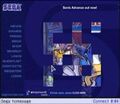Difference between revisions of "Dreamarena"
From Sega Retro
m (moved DreamArena to Dreamarena over redirect) |
|
(No difference)
| |
Revision as of 04:59, 23 January 2012
Dreamarena was a free online gaming service provided with all Sega Dreamcast consoles in Europe. As the console had a bundled 33.6 kbit/s modem built in (56 kbit/s in the USA), it was a dial-up service. This was created and operated for Sega Europe by a partnership between International Computers Limited, BT and various ISPs. ICL developed the web sites and software, with BT providing the dial-up capabilities and network infrastructure, and the ISPs (one for each country) providing the Internet dial-up connection and telephone service. The service was free to use (with the exception of regular call charges), and the game servers hosted within it could not otherwise be accessed from the Internet.
History
Dreamarena's website and ISP services launched on October 14, 1999, to coincide with the European launch of the Dreamcast. The launch of the hardware was delayed from its initial September 23 release date in order to finish preparations for the network features of the system. Despite this delay the infrastructure in place was insufficient to accommodate early demand, and users found themselves unable to register for and use the service. This issue prompted enough complaints to be featured on the BBC's consumer rights show Watchdog. Online gaming services had not launched at this point, as no compatible games had been released. As a result complaints of misleading advertising were also lodged with UK Independent Television Commission in November 1999, and were upheld resulting in an order to remove all references to online gaming from Dreamcast advertising.
In June 2000, Dreamarena's online gaming service went live with the release of Chu Chu Rocket. As an incentive to play online, Sega officially bundled the game with new hardware and offered a free copy of the game to every new and existing Dreamarena user. By July 2000, Sega had 300,000 registered Dreamarena users and had sent 100,000 free copies of Chu Chu Rocket. Also during this period, the Dreamarena website underwent a major redesign to tie in with the system's new brand image. To promote the new online gaming aspect of Dreamarena and tie in with the Euro 2000 football championship, Sega Europe produced a series of TV advertisements which highlighted cultural stereotypes and national rivalries within Europe. However, the marketing campaign once again ran afoul of the ITC, which branded the use of the phrase "Come and have a go if you think you're hard enough" "ill judged and irresponsible" and banned the campaign due to concerns over "condonement and possible encouragement of violence".
The Dreamarena website kept its second design for over a year and a half, and was updated regularly despite Sega's announced withdrawal from the console hardware business in January 2001. However, in the months that followed European Dreamcast games such as Daytona USA 2001, Outtrigger and Unreal Tournament were released without online play. The knowledge that this functionality existed in non-European copies of those games created ill feeling, as some consumers felt that promises had been broken.
Dreamarena was officially phased out in March 2002. Continued Dreamcast internet access was enabled with the release of Dreamkey 3.0 (and Dreamkey 3.1 in Spain/Portugal), which was the first PAL browser disc to officially allow users to choose their own dial-up ISP. The browser was available for a number of years, but has now been discontinued. The Dreamarena website was replaced with dedicated Dreamcast functionality on the official Sega Europe website, including chat, forums and webmail facilities. These facilities were retired one year later in March 2003, along with the internet functions for many PAL Dreamcast games. The final European Dreamcast game to go offline was the non-Dreamarena Phantasy Star Online in March 2007.


